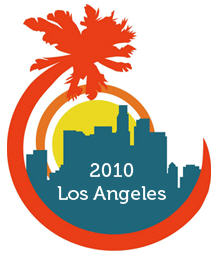Tuesday was tour day for conference attendees.
While some visited the National Archives of Australia (NAA) and the Public Records Office of Victoria (PROV), others visited the State Library of Victoria (SLV).
SLV genealogy librarian Anne Burrows – who presented her institution’s holdings to conference attendees on Monday – was the guide for our group. Her colleague Grant led another group.
 The SLV’s main reading room is a busy place, offering desks, computers as well as comfortable chairs for visitors. The room was full of people busily working away on their own laptops as well as the library’s computers.
The SLV’s main reading room is a busy place, offering desks, computers as well as comfortable chairs for visitors. The room was full of people busily working away on their own laptops as well as the library’s computers.
Just off the main reading room is the Genealogy Library, which is located in a former outdoor courtyard, now roofed over. Once considered for a restaurant, the space features elegant marble floors and tall stained glass windows of the surrounding buildings’ exterior walls. Sunlight streams through the roof’s glass panes into the room which holds shelving units, microfilm and microfiche cabinets and readers, as well as computers.
 In honor of the Australian Jewish genealogy conference, a dual-sided display of Jewish genealogy books, journals and newsletters was at the entrance to the room.
In honor of the Australian Jewish genealogy conference, a dual-sided display of Jewish genealogy books, journals and newsletters was at the entrance to the room.
Standing by the book display (left) is an old genealogy friend – Dr. Albert Braunstein of Melbourne – whose family, like mine, has roots in Mogilev, Belarus.
Anne took us through the room describing holdings in more detail.
In addition to the display at the entrance, there are more Jewish genealogy books on shelves, including many of Avotaynu’s publications – even Jeff Malka’s “Sephardic Genealogy” – and the Avotaynu journal. Of course, there are extensive general genealogy reference works and materials.
Microfiche includes holdings of the Australian Jewish Historical Society and other resources as indicated on this drawer label.

Computers also hold reference materials for those searching Jewish genealogy, such as databases on this computer in the center. A search for Australian Jewish Historical Society pulled up hits in the manuscript collection.
Patrons and researchers have access to printers for microfilm and microfiche images; digital cameras are allowed or users may download images directly to their own flash drives or memory sticks.
There are numerous GenieGuides covering Australian states and topics, such as convict material. Each binder holds many pages of additional sources of information (including selected microfiche, microfilm, CD and online records in the Genealogy Center. Although now only in hardcopy, future plans include online accessibility to this information.
Although I’m focusing in this post on the specific Jewish resources at the SLV, its extensive holdings include immigration records, vital records and much more, including the Ancestry.com Library Edition, available to all library visitors.
While the SLV’s Genealogy Collection focuses on sources from Australia, the UK and New Zealand, it also reflects Victoria’s ethnic diversity with an expanding range of Italian, Vietnamese, Chinese and Jewish material.
Core sources include indexes to civil registration for all Australian states and territories (as they are released), Australian cemetery and immigration records, electoral rolls and directions, and much more, including collective biographies and “how-to” guides.
The SLV’s Newspaper Reading Room holds more than 91,000 newspaper volumes in its Newspaper Collection – almost every newspaper published in the state since 1882, as well as earlier papers 1838-1880 (with some gaps).
Filed under: Australia, Avotaynu, Books, Jewish Heritage, Libraries, Research, Resources | Leave a comment »
 Web-based maps and mapping tools are the focus of the next meeting of the Jewish Genealogical Society of Greater Boston on Sunday, March 14.
Web-based maps and mapping tools are the focus of the next meeting of the Jewish Genealogical Society of Greater Boston on Sunday, March 14.


 The SLV’s main reading room is a busy place, offering desks, computers as well as comfortable chairs for visitors. The room was full of people busily working away on their own laptops as well as the library’s computers.
The SLV’s main reading room is a busy place, offering desks, computers as well as comfortable chairs for visitors. The room was full of people busily working away on their own laptops as well as the library’s computers.
